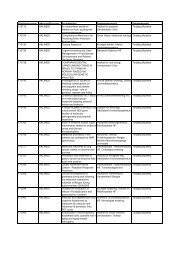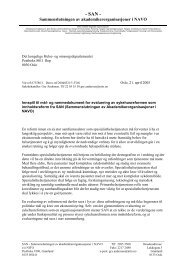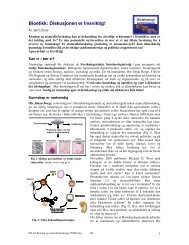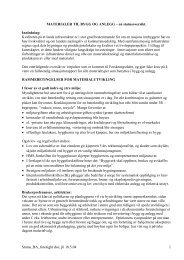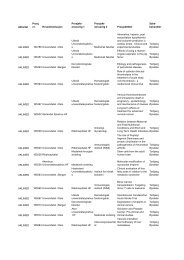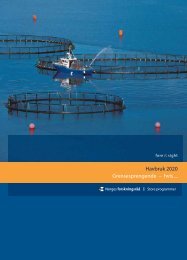A Revolution in R&D
A Revolution in R&D
A Revolution in R&D
You also want an ePaper? Increase the reach of your titles
YUMPU automatically turns print PDFs into web optimized ePapers that Google loves.
will not only help to make the trials faster and<br />
cheaper, but also allow some drugs to pass that<br />
would otherwise have failed ow<strong>in</strong>g to poor efficacy<br />
or side effects.<br />
High-Risk, High-Reward Research<br />
In the near-to-medium term, genetics promises to<br />
reduce R&D costs dramatically. Or does it? Our<br />
model shows that the application of disease genetics<br />
and pharmacogenetics together could, <strong>in</strong> the very<br />
best case, save as much as two-thirds of the current<br />
cost to develop a drug and nearly two years. Of<br />
these potential sav<strong>in</strong>gs, the vast majority comes<br />
from disease genetics. Of the rema<strong>in</strong>der, some cannot<br />
be clearly apportioned to either disease genetics<br />
or pharmacogenetics but must be credited to<br />
their jo<strong>in</strong>t efforts, be<strong>in</strong>g the product of synergies<br />
realized when disease genetics <strong>in</strong>formation is <strong>in</strong>corporated<br />
<strong>in</strong>to pharmacogenetics-driven cl<strong>in</strong>ical trials.<br />
(Although genetics can be comb<strong>in</strong>ed with the<br />
genomics technologies described <strong>in</strong> the previous<br />
chapter, the potential sav<strong>in</strong>gs are not additive. In<br />
the next chapter, we will assess the total sav<strong>in</strong>gs realistically<br />
achievable through the application of genomics<br />
and genetics.)<br />
Our model also shows that realiz<strong>in</strong>g this potential<br />
will be far from straightforward and is far from<br />
guaranteed. The high-end sav<strong>in</strong>gs estimate assumes<br />
a positive resolution of several scientific, technical,<br />
and market risks. With every setback, the sav<strong>in</strong>gs<br />
dim<strong>in</strong>ish. Too many setbacks, and the sav<strong>in</strong>gs fall to<br />
zero. Implement<strong>in</strong>g genetics could even turn out to<br />
have a negative impact on value, ow<strong>in</strong>g to adverse<br />
market dynamics.<br />
Such a double-edged sword is awkward to wield. If<br />
companies fail to grasp it at all, they forfeit the<br />
opportunity to reap enormous rewards—nearly<br />
double the sav<strong>in</strong>gs possible with genomics technologies.<br />
If they do grasp it, they put themselves <strong>in</strong><br />
some danger, and will need to develop a genetics<br />
strategy aligned with their risk profile and with specific<br />
market conditions. As an approach to research<br />
and development, genetics rema<strong>in</strong>s risky, but full of<br />
promise, too. This chapter assesses the promise and<br />
the risk alike.<br />
Disease Genetics<br />
Underly<strong>in</strong>g many diseases are genetic variants, or<br />
polymorphisms—alterations <strong>in</strong> the DNA sequence<br />
of a given gene that <strong>in</strong>fluence <strong>in</strong>dividual risk of disease.<br />
(The term polymorphism usually refers to a<br />
common variant—one found <strong>in</strong> more than 1 percent<br />
of the population.) Often the genetic difference<br />
consists of just a s<strong>in</strong>gle altered letter <strong>in</strong> the<br />
genetic code (the variant is then known as a s<strong>in</strong>gle<br />
nucleotide polymorphism, or SNP). Such a t<strong>in</strong>y alteration<br />
can have fatal consequences; for example, the<br />
substitution of an A for a T <strong>in</strong> the hemoglob<strong>in</strong> ß<br />
gene is responsible for sickle cell anemia. The goal<br />
of disease genetics is to identify such DNA alterations;<br />
so far, this goal has proved elusive for all but<br />
the most strongly <strong>in</strong>herited conditions. (See sidebar,<br />
“Disease Genetics—Various Approaches to<br />
Variants.”) But researchers persevere, s<strong>in</strong>ce f<strong>in</strong>d<strong>in</strong>g<br />
the causal variants can be a major step to f<strong>in</strong>d<strong>in</strong>g a<br />
treatment—and potentially a cure.<br />
Uncerta<strong>in</strong>ty persists: the technologies have yet to<br />
prove their full worth by produc<strong>in</strong>g the necessary<br />
quota of practical results. But if all goes accord<strong>in</strong>g<br />
to plan, the sav<strong>in</strong>gs realized by pharmaceutical<br />
companies will be enormous.<br />
The Potential<br />
The sav<strong>in</strong>gs would come partially from improved<br />
efficiency <strong>in</strong> discovery, but pr<strong>in</strong>cipally from<br />
improved success <strong>in</strong> target validation and cl<strong>in</strong>ical<br />
trials. The improvements <strong>in</strong> efficiency result from<br />
the consolidation of target discovery <strong>in</strong>to a s<strong>in</strong>gle<br />
step; the improved success rates result from the<br />
ref<strong>in</strong><strong>in</strong>g of target identification, mak<strong>in</strong>g it possible<br />
to p<strong>in</strong>po<strong>in</strong>t the targets associated with disease susceptibility<br />
<strong>in</strong> humans.<br />
Once the targets have been located, they can boast<br />
a collective superiority <strong>in</strong> three particular respects.<br />
First, their relevance to human disease is certa<strong>in</strong>.<br />
They have, after all, been validated <strong>in</strong> humans,<br />
show<strong>in</strong>g directly that modulation of gene activity<br />
leads to alteration <strong>in</strong> the <strong>in</strong>tensity or duration of<br />
disease. (By contrast, other targets are usually iden-<br />
27



